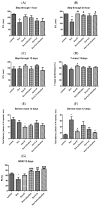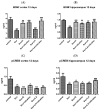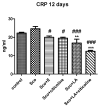Memory Recovery Effect of a New Bioactive Innovative Combination in Rats with Experimental Dementia
- PMID: 38136170
- PMCID: PMC10740861
- DOI: 10.3390/antiox12122050
Memory Recovery Effect of a New Bioactive Innovative Combination in Rats with Experimental Dementia
Abstract
Alzheimer's disease manifests as a complex pathological condition, with neuroinflammation, oxidative stress and cholinergic dysfunction being a few of the many pathological changes. Due to the complexity of the disease, current therapeutic strategies aim at a multitargeted approach, often relying on a combination of substances with versatile and complementary effects. In the present study, a unique combination of α-lipoic acid, citicoline, extracts of leaves from olive tree and green tea, vitamin D3, selenium and an immune-supporting complex was tested in scopolamine-induced dementia in rats. Using behavioral and biochemical methods, we assessed the effects of the combination on learning and memory, and elucidated the mechanisms of these effects. Our results showed that, compared to its components, the experimental combination was most efficient in improving short- and long-term memory as assessed by the step-through method as well as spatial memory as assessed by T-maze and Barnes maze underlined by decreases in AChE activity (p < 0.05) and LPO (p < 0.001), increases in SOD activity in the cortex (p < 0.05) and increases in catalase (p < 0.05) and GPx (p < 0.01) activities and BDNF (p < 0.001) and pCREB (p < 0.05) levels in the hippocampus. No significant histopathological changes or blood parameter changes were detected, making the experimental combination an effective and safe candidate in a multitargeted treatment of AD.
Keywords: Alzheimer’s disease; citicoline; extract of leaves green tea; extract of leaves olive tree; scopolamine; selenium; vitamin D3; α-lipoic acid.
Conflict of interest statement
The authors declare that the research was conducted in the absence of any commercial or financial relationships that could be regarded as a potential conflict of interest.
Figures










Similar articles
-
The modulatory role of prime identified compounds in Geophila repens in mitigating scopolamine-induced neurotoxicity in experimental rats of Alzheimer's disease via attenuation of cholinesterase, β-secretase, MAPt levels and inhibition of oxidative stress imparts inflammation.J Ethnopharmacol. 2022 Jan 10;282:114637. doi: 10.1016/j.jep.2021.114637. Epub 2021 Sep 14. J Ethnopharmacol. 2022. PMID: 34534598
-
GAPT regulates cholinergic dysfunction and oxidative stress in the brains of learning and memory impairment mice induced by scopolamine.Brain Behav. 2020 May;10(5):e01602. doi: 10.1002/brb3.1602. Epub 2020 Mar 15. Brain Behav. 2020. PMID: 32174034 Free PMC article.
-
Cornuside ameliorates cognitive impairments in scopolamine induced AD mice: Involvement of neurotransmitter and oxidative stress.J Ethnopharmacol. 2022 Jul 15;293:115252. doi: 10.1016/j.jep.2022.115252. Epub 2022 Apr 9. J Ethnopharmacol. 2022. PMID: 35405255
-
Ameliorative effects of Matricaria chamomilla L. hydroalcoholic extract on scopolamine-induced memory impairment in rats: A behavioral and molecular study.Phytomedicine. 2018 Aug 1;47:113-120. doi: 10.1016/j.phymed.2018.04.049. Epub 2018 May 7. Phytomedicine. 2018. PMID: 30166095
-
Effect of Sinapic Acid on Scopolamine-Induced Learning and Memory Impairment in SD Rats.Brain Sci. 2023 Mar 1;13(3):427. doi: 10.3390/brainsci13030427. Brain Sci. 2023. PMID: 36979237 Free PMC article.
Cited by
-
Can the combination of citicoline and vitamin B12 be beneficial in the healing of corneal nerves after corneal cross-linking?Int Ophthalmol. 2025 Jan 31;45(1):54. doi: 10.1007/s10792-025-03433-5. Int Ophthalmol. 2025. PMID: 39890769
-
Metformin Mitigates Trimethyltin-Induced Cognition Impairment and Hippocampal Neurodegeneration.Cell Mol Neurobiol. 2024 Oct 23;44(1):70. doi: 10.1007/s10571-024-01502-4. Cell Mol Neurobiol. 2024. PMID: 39441380 Free PMC article.
References
Grants and funding
LinkOut - more resources
Full Text Sources

